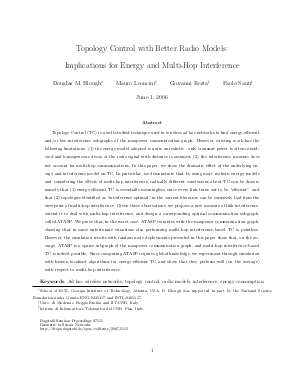Topology Control with Better Radio Models: Implications for Energy and Multi-Hop Interference
Authors Paolo Santi, Douglas M. Blough, Mauro Leoncini, Giovanni Resta
-
Part of:
Volume:
Dagstuhl Seminar Proceedings, Volume 7151
Part of: Series: Dagstuhl Seminar Proceedings (DagSemProc) - License:
 Creative Commons Attribution 4.0 International license
Creative Commons Attribution 4.0 International license
- Publication Date: 2007-07-11
File

PDF
DagSemProc.07151.3.pdf
- Filesize: 427 kB
- 26 pages
Document Identifiers
Subject Classification
Keywords
- Wireless ad hoc networks
- wireless sensor networks
- energy consumption
- multi-hop intereference
- topology control
Metrics
- Access Statistics
-
Total Accesses (updated on a weekly basis)
0Document
0Metadata
Abstract
The goal of this talk is to understand the impact of simplifications done in modeling WSN on practical usefulness of the obtained theoretical results. We start with the well-know triangular inequality argument used to motivate construction of power-efficient topologies for WSN, and we show how considering realistic energy models, the conclusion drawn in classical results on power spanners (two short hops are better than a long one) is actually reversed. We then question about practical relevance of other metrics (e.g., low degree) considered very important in the topology control literature.
Cite As Get BibTex
Paolo Santi, Douglas M. Blough, Mauro Leoncini, and Giovanni Resta. Topology Control with Better Radio Models: Implications for Energy and Multi-Hop Interference. In Geometry in Sensor Networks. Dagstuhl Seminar Proceedings, Volume 7151, pp. 1-26, Schloss Dagstuhl – Leibniz-Zentrum für Informatik (2007)
https://doi.org/10.4230/DagSemProc.07151.3
BibTex
@InProceedings{santi_et_al:DagSemProc.07151.3,
author = {Santi, Paolo and Blough, Douglas M. and Leoncini, Mauro and Resta, Giovanni},
title = {{Topology Control with Better Radio Models: Implications for Energy and Multi-Hop Interference}},
booktitle = {Geometry in Sensor Networks},
pages = {1--26},
series = {Dagstuhl Seminar Proceedings (DagSemProc)},
ISSN = {1862-4405},
year = {2007},
volume = {7151},
editor = {Subhash Suri and Roger Wattenhofer and Peter Widmayer},
publisher = {Schloss Dagstuhl -- Leibniz-Zentrum f{\"u}r Informatik},
address = {Dagstuhl, Germany},
URL = {https://drops.dagstuhl.de/entities/document/10.4230/DagSemProc.07151.3},
URN = {urn:nbn:de:0030-drops-11152},
doi = {10.4230/DagSemProc.07151.3},
annote = {Keywords: Wireless ad hoc networks, wireless sensor networks, energy consumption, multi-hop intereference, topology control}
}
